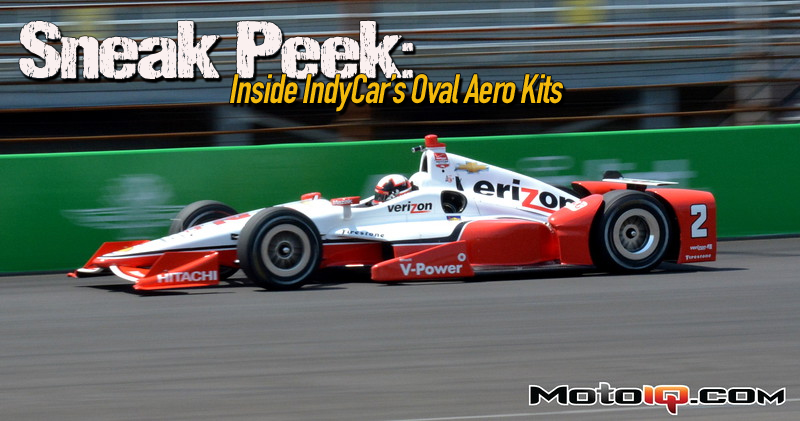,
 Chevrolet has done a lot more work on their front wing and it is nothing like Honda’s or Dallara’s. While Honda’s wing seems more like a modified and optimized Dallara part, the Chevy wing is very bespoke. The outer edge and fence are quite similar to the road course wing Chevy uses. This wing also seems to divert more air over the front tire than the Honda wing does. Also note the adjusters on the outside of the end fence (just over the first ‘H’ in Hitachi). The Chevy teams can fine tune their downforce on each corner if conditions change mid-race. Once again, the main plane of the wing is contoured to direct air under the floor of the car. Another new addition to all of the cars in 2015 is the small rib running along the nose of the car. These can help prevent the cars from flipping over when they spin out.
Chevrolet has done a lot more work on their front wing and it is nothing like Honda’s or Dallara’s. While Honda’s wing seems more like a modified and optimized Dallara part, the Chevy wing is very bespoke. The outer edge and fence are quite similar to the road course wing Chevy uses. This wing also seems to divert more air over the front tire than the Honda wing does. Also note the adjusters on the outside of the end fence (just over the first ‘H’ in Hitachi). The Chevy teams can fine tune their downforce on each corner if conditions change mid-race. Once again, the main plane of the wing is contoured to direct air under the floor of the car. Another new addition to all of the cars in 2015 is the small rib running along the nose of the car. These can help prevent the cars from flipping over when they spin out. The back side of the Chevy wing, as seen on Sebastian Bourdais' car, has a diverter built into the scoop outside of the end fence. Judging by the shape of this part of the wing, it seems air here is being directed around the front tire. The Honda wing seems to direct air into the squish zone in front of the tire, which would divert that air to the bottom side of the tire.
The back side of the Chevy wing, as seen on Sebastian Bourdais' car, has a diverter built into the scoop outside of the end fence. Judging by the shape of this part of the wing, it seems air here is being directed around the front tire. The Honda wing seems to direct air into the squish zone in front of the tire, which would divert that air to the bottom side of the tire.  Moving onto the sidepods and radiator inlets, The radiator openings of Helio Castroneves' Chevy are very large. Large inlets like these would contribute to quite a lot of drag. However it is possible that Chevy is channeling this air through the body and over the top of the floor. In the CAD rendering you can see the back of the sidepod is vented. Unfortunately, we did not capture a good angle of this venting in our sleuthing.
Moving onto the sidepods and radiator inlets, The radiator openings of Helio Castroneves' Chevy are very large. Large inlets like these would contribute to quite a lot of drag. However it is possible that Chevy is channeling this air through the body and over the top of the floor. In the CAD rendering you can see the back of the sidepod is vented. Unfortunately, we did not capture a good angle of this venting in our sleuthing. Contrast Chevy’s large ducts with the tiny ducting on Marco Andretti's Honda. The upper duct is definitely for the heat exchangers. However that smaller NACA duct at the bottom seems to feed air directly through the sidepod and out over the rear wheel. The top of the fender is open, so this is likely blown bodywork. Again, we did not see the inside of the side pods, but Honda probably merges the air coming off the radiators with this cleaner air before sending it out back. Once again, this probably helps the diffuser. You may have noticed the large hole in the floor next to the sidepod. IndyCar mandated these cutouts for all cars to help reign in downforce after the road course kits were showing huge jumps in downforce. These holes cut 300 lbs of downforce from the road course kits and every pole lap so far in 2015 has been a record for IndyCar. Imagine how much quicker they’d be with all that extra grip!
Contrast Chevy’s large ducts with the tiny ducting on Marco Andretti's Honda. The upper duct is definitely for the heat exchangers. However that smaller NACA duct at the bottom seems to feed air directly through the sidepod and out over the rear wheel. The top of the fender is open, so this is likely blown bodywork. Again, we did not see the inside of the side pods, but Honda probably merges the air coming off the radiators with this cleaner air before sending it out back. Once again, this probably helps the diffuser. You may have noticed the large hole in the floor next to the sidepod. IndyCar mandated these cutouts for all cars to help reign in downforce after the road course kits were showing huge jumps in downforce. These holes cut 300 lbs of downforce from the road course kits and every pole lap so far in 2015 has been a record for IndyCar. Imagine how much quicker they’d be with all that extra grip! At the back of Hunter-Reay's car we can get a good look at the rear wheel guards. We can also see into the side pod. Honda seems to have gone to great lengths to keep the air going over the body separate from the air coming off the tires and the heat exchangers. Smoothing the airflow would increase the efficiency of the underbody aero.
At the back of Hunter-Reay's car we can get a good look at the rear wheel guards. We can also see into the side pod. Honda seems to have gone to great lengths to keep the air going over the body separate from the air coming off the tires and the heat exchangers. Smoothing the airflow would increase the efficiency of the underbody aero.


